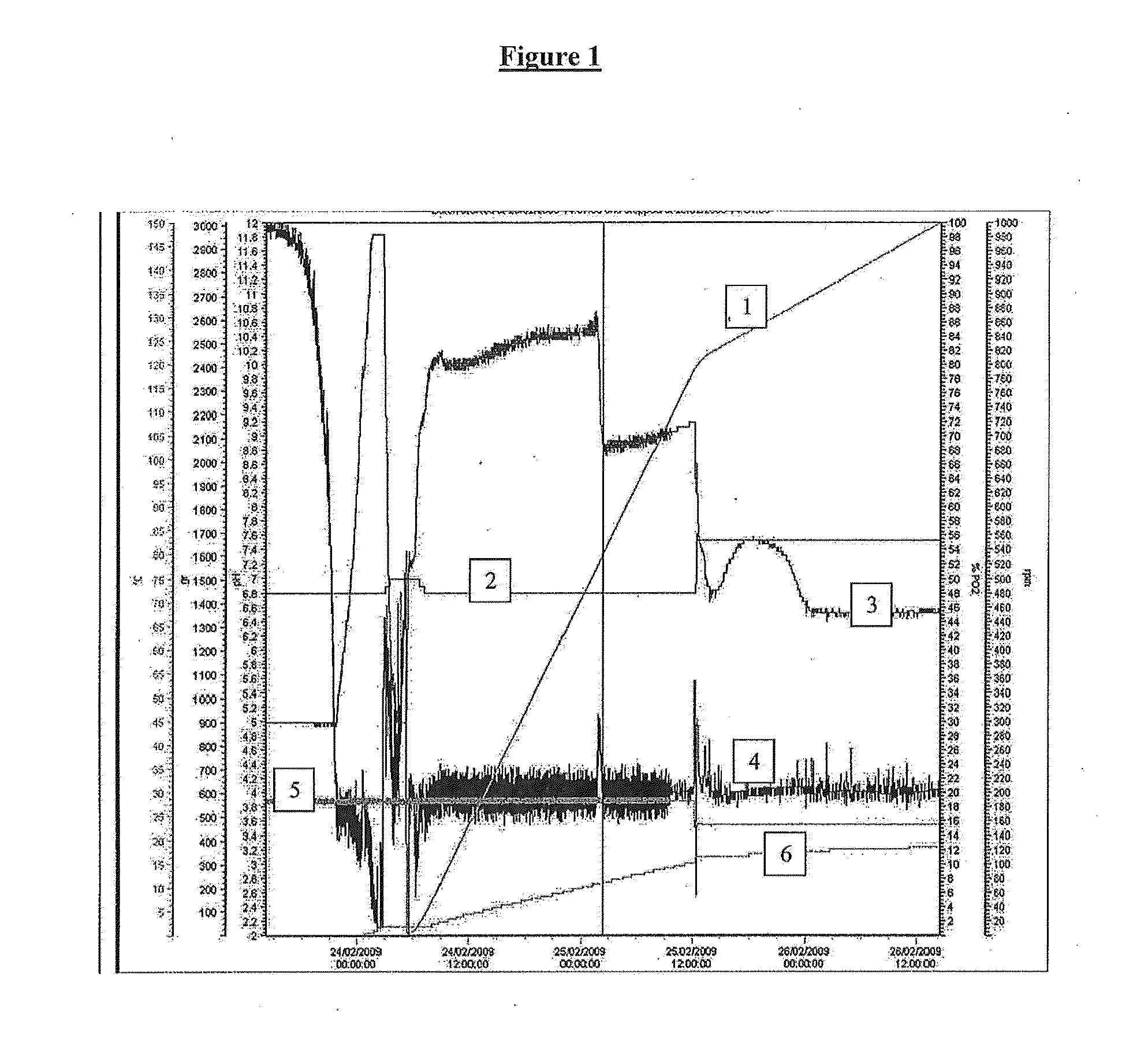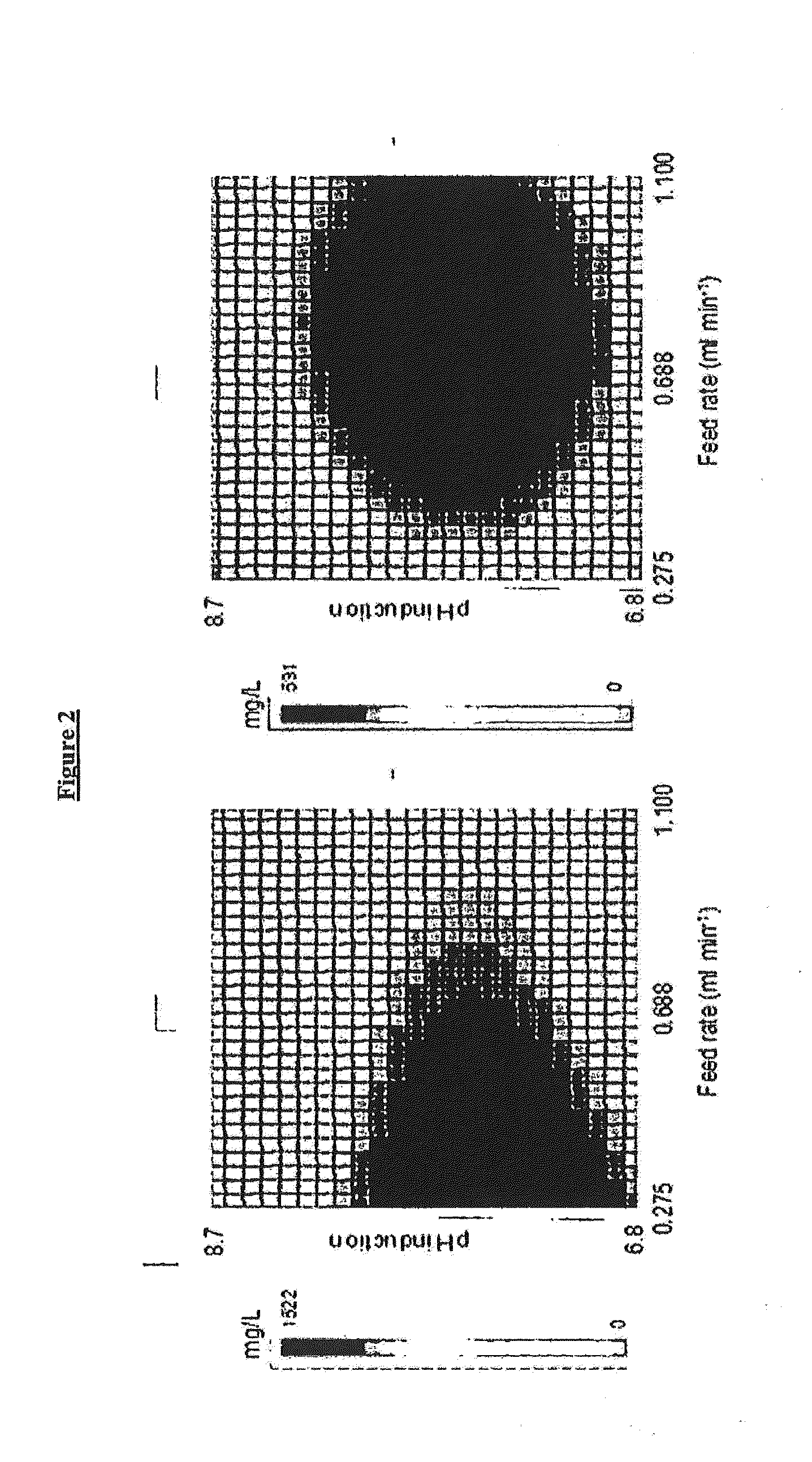Fermentation process
- Summary
- Abstract
- Description
- Claims
- Application Information
AI Technical Summary
Benefits of technology
Problems solved by technology
Method used
Image
Examples
example 1
Escherichia coli B2355 Pre-Culture
[0261]A pre-culture was prepared using a frozen seed culture of Escherichia coli strain B2355. This strain is a B834(DE3) strain transformed with a pET26b derivative containing a sequence coding for a fusion protein between the signal peptide of FIG. 1 from E. coli (SEQ ID NO:23) and CRM197 (SEQ. ID NO:27). The seed culturability was determined as approximately 1×1010 colony forming units per ml.
[0262]The seed culture was thawed to room temperature and 400 μl were used to inoculate a 2 litre Erlenmeyer flask containing 400 ml of precuiture medium (adapted: from Zabriskie et al, (J. Ind. Microbiol. 2:87-95 (1987))).
[0263]The inoculated flask was then incubated at 37° C. (±1° C.) and 200 rpm. The pre-culture phase was stopped when the culture gained an optical density at 650 nm (OD650nm) of between 0.5 and 1.5, (around 5h of incubation). The pre-culture was used to inoculate medium in a fermenter as soon as the culture was stopped (example 2).
example 2
20L Scale Fedbatch Fermentation
[0264]A 20 litre fermenter (Biolafilte) was used. Nine litres of batch phase medium were asepfically transferred into the fermenter (adapted from Zabriskie et ai. (J. Ind. Microbiol. 2:87-95 (1987)). The pH of the medium was adjusted to 6.8 with base addition. 3 ml of undiluted irradiated antifoam (SAG 471) was also added to the fermenter. The temperature (28° C.), head pressure (0.5 bar), aeration rate (20 litres sparged air per minute) and initial agitation speed (300 rpm) were then sst prior to inoculation. The level of dissolved oxygen in these conditions was 100%, The head pressure and aeration rate were maintained at a constant level during the fermentation.
[0265]Inoculation was achieved by the addition of about 20 ml of pre-culture (prepared as described in Example 1).
[0266]During batch phase (0-15h), the temperature was maintained at 28° C. The level of dissolved oxygen was set at 20%. The level of dissolved oxygen (DO) was regulated by increas...
example 3
Determination of the Optimum Feed Rates and pH to be Used During the Induction Phase
[0275]In this experiment response-surface methodology (J.ind. Microbiol. Biotechnol. 37:195-204 (2010)) was used to determine optimal values for three parameters, in order to maximize periplasmic production of a recombinant protein. The three fermentation parameters investigated were the pH during the growth phase, the pH during induction and the feed rate during induction. Values for these three parameters were chosen according to a Doehiert uniform shell design (Doehlert (Applied Statistics 19:231-239 (1970))). Fifteen fermentations were carried out using the values described in table 5.
[0276]The fermentations were carried out using strain B2284, this is a strain of BLR (DE3) cells transformed with a pET26b derivative containing a sequence coding for a fusion protein between the signal peptide of Flgl (SEQ ID NO:23)from E. coli and the mature part of CRM197 (SEQ ID NO:27).
[0277]For each fermentatio...
PUM
| Property | Measurement | Unit |
|---|---|---|
| Temperature | aaaaa | aaaaa |
| Temperature | aaaaa | aaaaa |
| Temperature | aaaaa | aaaaa |
Abstract
Description
Claims
Application Information
 Login to View More
Login to View More - R&D
- Intellectual Property
- Life Sciences
- Materials
- Tech Scout
- Unparalleled Data Quality
- Higher Quality Content
- 60% Fewer Hallucinations
Browse by: Latest US Patents, China's latest patents, Technical Efficacy Thesaurus, Application Domain, Technology Topic, Popular Technical Reports.
© 2025 PatSnap. All rights reserved.Legal|Privacy policy|Modern Slavery Act Transparency Statement|Sitemap|About US| Contact US: help@patsnap.com



